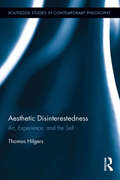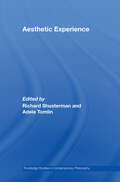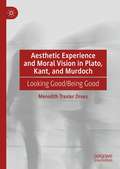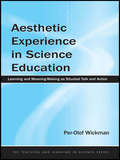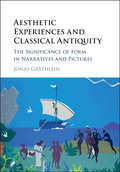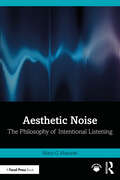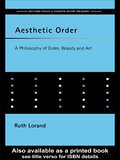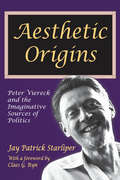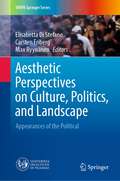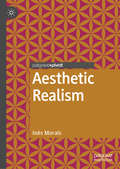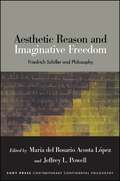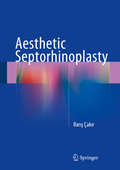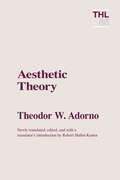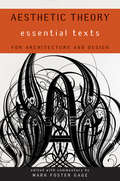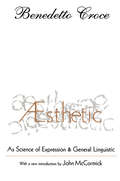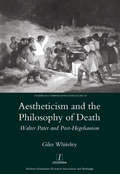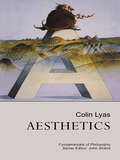- Table View
- List View
Aesthetic Disinterestedness: Art, Experience, and the Self (Routledge Studies in Contemporary Philosophy)
by Thomas HilgersThe notion of disinterestedness is often conceived of as antiquated or ideological. In spite of this, Hilgers argues that one cannot reject it if one wishes to understand the nature of art. He claims that an artwork typically asks a person to adopt a disinterested attitude towards what it shows, and that the effect of such an adoption is that it makes the person temporarily lose the sense of herself, while enabling her to gain a sense of the other. Due to an artwork’s particular wealth, multiperspectivity, and dialecticity, the engagement with it cannot culminate in the construction of world-views, but must initiate a process of self-critical thinking, which is a precondition of real self-determination. Ultimately, then, the aesthetic experience of art consists of a dynamic process of losing the sense of oneself, while gaining a sense of the other, and of achieving selfhood. In his book, Hilgers spells out the nature of this process by means of rethinking Kant’s and Schopenhauer’s aesthetic theories in light of more recent developments in philosophy–specifically in hermeneutics, critical theory, and analytic philosophy–and within the arts themselves–specifically within film and performance art.
Aesthetic Experience (Routledge Studies in Contemporary Philosophy)
by Richard Shusterman Adele TomlinIn this volume, a team of internationally respected contributors theorize the concept of aesthetic experience and its value. Exposing and expanding our restricted cultural and intellectual presuppositions of what constitutes aesthetic experience, the book aims to re-explore and affirm the place of aesthetic experience--in its evaluative, phenomenological and transformational sense--not only in relation to art and artists but to our inner and spiritual lives.
Aesthetic Experience and Moral Vision in Plato, Kant, and Murdoch: Looking Good/Being Good
by Meredith Trexler DreesThis book addresses how Plato, Kant, and Iris Murdoch (each in different ways) view the connection aesthetic experience has to morality. While offering an examination of Iris Murdoch’s philosophy, it analyses deeply the suggestive links (as well as essential distinctions) between Plato’s and Kant’s philosophies. Meredith Trexler Drees considers not only Iris Murdoch’s concept of unselfing, but also its relationship with Kant’s view of Achtung and Plato’s view of Eros. In addition, Trexler Drees suggests an extended, and partially amended, version of Murdoch’s view, arguing that it is more compatible with a religious way of life than Murdoch herself realized. This leads to an expansion of the overall argument to include Kant’s affirmation of religion as an area of life that can be improved through Plato’s and Murdoch’s vision of how being good and being beautiful can be part of the same life-task.
Aesthetic Experience in Science Education: Learning and Meaning-Making as Situated Talk and Action (Teaching and Learning in Science Series)
by Per-Olof WickmanThis book examines the role of aesthetic experience in learning science and in science education from the perspective of knowledge as action and language use. The theoretical underpinnings are based on the writings of John Dewey and Ludwig Wittgenstein. In their spirit aesthetics is examined as it appears in the lives of people and how it relates to the activities in which they are involved.Centered around an empirical analysis of how students and their teachers use aesthetic language and acts during laboratory and field work, the book demonstrates that aesthetics is something that is constantly talked about in science class and that these aesthetic experiences are intimately involved in learning science. These empirical findings are related to current debates about the relation between aesthetics and science, and about motivation, participation, learning and socio-cultural issues in science education. This book features:*an empirical demonstration of the importance and specific roles of aesthetic experiences in learning science;*a novel contribution to the current debate on how to understand motivation, participation and learning; and*a new methodology of studying learning in action.Part I sketches out the theoretical concepts of Wickman's practical epistemology analysis of the fundamental role of aesthetics in science and science education. Part II develops these concepts through an analysis of the use of aesthetic judgments when students and teachers are talking in university science classes. Part III sums up the general implications of the theoretical underpinnings and empirical findings for teaching and learning science. Here Wickman expands the findings of his study beyond the university setting to K-8 school science, and explicates what it would mean to make science education more aesthetically meaningful.Wickman's conclusions deal to a large extent with aesthetic experience as individual transformation and with people's prospects for participation in an activity such as science education. These conclusions have significance beyond science teaching and learning that should be of concern to educators generally. This book is intended for educational researchers, graduate students, and teacher educators in science education internationally, as well as those interested in aesthetics, philosophy of education, discourse analysis, socio-cultural issues, motivation, learning and meaning-making more generally.
Aesthetic Experiences and Classical Antiquity: The Significance of Form in Narratives and Pictures
by Jonas GrethleinIn this bold book, Jonas Grethlein proposes a new dialogue between the fields of Classics and aesthetics. Ancient material, he argues, has the capacity to challenge and re-orientate current debates. Comparisons with modern art and literature help to balance the historicism of classical scholarship with transcultural theoretical critique. Grethlein discusses ancient narratives and pictures in order to explore the nature of aesthetic experience. While our responses to both narratives and pictures are vicarious, the 'as-if' on which they are premised is specifically shaped by the form of the representation. Form emerges as a key to how narratives and pictures constitute an important means of engaging with experience. Combining theoretical reflections with close readings, this book will appeal to art historians as well as to textual scholars.
Aesthetic Noise: The Philosophy of Intentional Listening
by Mary G. MazurekAesthetic Noise: The Philosophy of Intentional Listening considers the complex nature of noise within the framework of philosophical filtering, examining how, if noise is engaged with aesthetically, it can produce profound experiences and understandings.Applying the philosophies of Edmund Burke, Martin Heidegger, Jacque Derrida, and Julia Kristeva to works by Luigi Russolo, John Cage, Steve Reich, Alison Knowles, Annea Lockwood, Alyce Santoro, and Sunn O))), this book explores noise as an art material, and ultimately how it can become a tool for activism and expanded creative possibilities. It demonstrates that, by engaging multiple philosophies in concert, the value of aesthetic noise is amplified, thus allowing the listener to better appreciate noise and its possibilities.Providing greater insights into noise as an aesthetic material, Aesthetic Noise will be of interest to researchers and students of sound studies, philosophy, and sound art, as well as sound designers, artists, musicians, and composers.
Aesthetic Order: A Philosophy of Order, Beauty and Art (Routledge Studies in Twentieth-Century Philosophy)
by Ruth LorandAesthetic Order challenges contemporary theories of aesthetics, offering the idea of beauty as quantitative yet different from the traditional discursive order. It will be of importance to all interested in aesthetic theory.
Aesthetic Origins: Peter Viereck and the Imaginative Sources of Politics
by Claes G. Ryn Jay Patrick StarliperWhile it is gaining in academic prominence, discussion of the imagination is too often neglected. Society is dangerously unaware of the intimate relationship between culture and politics, ethics and aesthetics. Challenging this, Jay Patrick Starliper examines the imagination through the lens of the work of Peter Viereck and other likeminded thinkers. The result is a philosophical deconstruction that demonstrates why books are bullets.In 1941, before Nazi barbarism was public knowledge, a young Peter Viereck published Metapolitics: From Wagner and the German Romantics to Hitler. In it, Viereck attacked the diabolical spiritual foundations of National Socialism. He made the ostensibly absurd claim that a certain shade of romanticism was the ethical foundation of a German revolt against decency. According to Viereck, Nazism was the culmination of over a century and a half of bad culture, the result of an idyllic imagination. Starliper warns that the same diseased imagination that culminated in gas chambers and guillotines is subtly affecting the way millions of people view the world today and that, without the inspiration of an elevated aesthetic, civilization will not survive.In the spirit of Edmund Burke and Irving Babbitt, Viereck's insight into the ethical and political force of aesthetics provides a much needed critique of contemporary civilization.
Aesthetic Perspectives on Culture, Politics, and Landscape: Appearances of the Political (UNIPA Springer Series)
by Max Ryynänen Elisabetta Di Stefano Carsten FribergThis book investigates how we are involved in politically informed structures and how they appear to us. Following different approaches in contemporary aesthetics and cultural philosophy, such as everyday aesthetics, atmosphere and aestheticization, the contributions explore how embedded powers in politics, education, democracy, and landscape are analyzed through aesthetics.
Aesthetic Poetry
by Walter PaterTHE "aesthetic" poetry is neither a mere reproduction of Greek or medieval poetry, nor only an idealisation of modern life and sentiment. <P> <P> The atmosphere on which its effect depends belongs to no simple form of poetry, no actual form of life. Greek poetry, medieval or modern poetry, projects, above the realities of its time, a world in which the forms of things are transfigured. Of that transfigured world this new poetry takes possession, and sublimates beyond it another still fainter and more spectral, which is literally an artificial or "earthly paradise."
Aesthetic Realism
by Inês MoraisThis compelling book defends realism concerning the aesthetic—in particular, concerning the aesthetic properties of works of art (including works of literature). Morais lucidly argues that art criticism, when referring to aesthetic properties, is referring not ultimately to the critic’s subjective reactions, but to genuine properties of the works. With a focus on contemporary discussion conducted in the analytic tradition, as well as on arguments by Hume and Kant, this book characterizes the debate in aesthetics and the philosophy of art concerning aesthetic realism, examining attacks on the objectivity of values, the ‘autonomy thesis’, and Hume’s sentimentalism. Considering and defusing scepticism concerning the significance of the ontological debate about aesthetic realism, Morais discusses two powerful attacks on aesthetic realism before defending the doctrine against them and providing a positive realist account of aesthetic properties.
Aesthetic Reason and Imaginative Freedom: Friedrich Schiller and Philosophy (SUNY series in Contemporary Continental Philosophy)
by María del Rosario Acosta López; Jeffrey L. PowellThis book seeks to draw attention to Friedrich Schiller (1759–1805) as a philosophical thinker in his own right. For too long, his philosophical contribution has been neglected in favor of his much-deserved reputation as a political playwright. The essays in this collection make two arguments. First, Schiller presents a robust philosophical program that can be favorably compared to those of his age, including Rousseau, Kant, Schelling, and Hegel, and he proves to be their equal in his thinking on morality, aesthetics, and politics. Second, Schiller can also guide us in our more contemporary philosophical concerns and approaches, such as phenomenology, hermeneutics, aesthetics, and politics. Here, Schiller instructs us in our engagement with figures such as Walter Benjamin, Michel Foucault, Jacques Rancière, Roberto Esposito, and others.
Aesthetic Septorhinoplasty
by Barış ÇakırThis superbly illustrated book describes how techniques previously developed by Dr. Rollin Daniel for use in open rhinoplasty can be adapted for use in the closed approach. It is the author's opinion that this combination offers greater feedback during surgery, a shorter recovery period and absence of scar. Full explanation is provided of preoperative preparation, including evaluation of the nasal surface aesthetics using the concept of geometric polygons as aesthetic subunits to define both the existing deformity and the aesthetic goals. The surgical techniques developed and modified to achieve the desired surface appearance are then described step by step with the aid of a wealth of color photos. It is illustrated how the novel dissection and redrape control methods reduce the healing time and enhance outcome and an extensive series of case analyses is presented to document the benefits of the approach. The book is written in a "cookbook format" that will enable plastic surgeons quickly to learn how to utilize the closed approach to rhinoplasty to optimal aesthetic benefit.
Aesthetic Theory
by Theodor W. AdornoPerhaps the most important aesthetics of the twentieth century appears here newly translated, in English that is for the first time faithful to the intricately demanding language of the original German. The culmination of a lifetime of aesthetic investigation, Aesthetic Theory is Theodor W. Adorno's magnum opus, the clarifying lens through which the whole of his work is best viewed, providing a framework within which his other major writings cohere. Translated by Robert Hullot-Kentor.
Aesthetic Theory: Construction Of The Aesthetic (Theory and History of Literature #88)
by Theodor W. AdornoPerhaps the most important aesthetics of the twentieth century appears here newly translated, in English that is for the first time faithful to the intricately demanding language of the original German.The culmination of a lifetime of aesthetic investigation, Aesthetic Theory is Adorno&’s major work, a defense of modernism that is paradoxical in its defense of illusion. In it, Adorno takes up the problem of art in a day when &“it goes without saying that nothing concerning art goes without saying.&” In the course of his discussion, Adorno revisits such concepts as the sublime, the ugly, and the beautiful, demonstrating that concepts such as these are reservoirs of human experience. These experiences ultimately underlie aesthetics, for in Adorno&’s formulation &“art is the sedimented history of human misery.&”Robert Hullot-Kentor&’s translation painstakingly, yet fluently, reproduces the nuances and particularities of the original. Long awaited and significant, Aesthetic Theory is the clarifying lens through which the whole of Adorno&’s work is best viewed, providing a framework within which his other major writings cohere.
Aesthetic Theory: Essential Texts
by Mark Foster GageA collection of pivotal ideas about beauty from throughout history, with an introduction and critical headnotes. This collection of writings on beauty includes selections from twenty key philosophers and theoreticians spanning two millennia: Plato • Aristotle • Vitruvius • Alberti • Kant • Burke • Fiedler • Nietzsche • Wilde • Bergson • Bell • Scott • Benjamin • Bataille • Sontag • Jameson • Scarry • Nehamas • Zangwill • Freedberg and Gallese With an introduction and critical headnotes explaining the importance of each text, Mark Foster Gage offers a framework for a provocative history of ideas about beauty as they relate to contemporary thinking on architecture and design. In a world increasingly defined by sumptuous visuality, the concepts of beauty and visual sensation are not mere intellectual exercises but standards that define the very nature of design practice across disciplines and that are essential to the emerging worlds of design and architecture in the twenty-first century.
Aesthetic: As Science of Expression and General Linguistic
by Benedetto Croce John McCormick Douglas AinslieBenedetto Croce is one of the most influential philosophers of the twentieth century. His work in aesthetics and historiography has been controversial, but enduring. When the first edition of ^Esthetic appeared in 1902, Croce was seen as foremost in reasserting an idealistic philosophy, which despite its source in continental idealists from Descartes to Hegel, offers a system that attempts to account for the emergence of scientific systems. Croce thus combines scientific and metaphysical thought into a dynamic aesthetic.Croce regards aesthetics not merely as a branch of philosophy, but as a fundamental human activity. It is inseparable from historical, psychological, political, economic, and moral considerations, no less than a unique frame of artistic reference. Aesthetic is composed of two parts: Part One concentrates on aesthetic theory and practice. Among the topics it covers are: intuition and expression, art and philosophy, historicism and intellectualism, and beauty in nature and in art. Part Two is devoted to the history of aesthetics. Croce analyzes such subjects as: aesthetic ideas in the Middle Ages and Renaissance, Giambattista Vico as the inventor of aesthetic science, the philosophy of language, and aesthetic psychologism.In his new introduction to a classic translation, John McCormick assesses Croce's influence in aesthetic theory and historiography. He notes that the republication of this work is an overdue appreciation of a singular effort to resolve the classic questions of the philosophy of art, art for its own sake and art as a social enterprise; both find a place in Croce's system.
Aestheticism and the Philosophy of Death: Walter Pater and Post-Hegelianism
by Giles Whitely"Walter Pater, best known as the author of The Renaissance (1873) and as Oscar Wildes tutor and friend, was a leading figure in European aestheticism and British fin-de-siecle culture. Despite this, he has received only limited critical attention, and has tended to be read conservatively. Drawing on Paters unpublished manuscripts, Giles Whiteley challenges this view of Pater as a closeted don who spend the remainder of his life regretting the excesses of his Renaissance. Focusing on Paters reading of the German idealist philosopher, G. W. F. Hegel, Whiteley argues that Paters response to both the philosophical and the ideological legacies of idealism was significantly more advanced than has been hitherto thought. Presenting a persuasive new reading of the genre of the imaginary portrait Paters most elusive form of writing the book paints a picture of Walter Pater as a truly revolutionary thinker. Pater, like Nietzsche during the same period, breaks with the dialectic as a method. Anticipating the radical critiques of ideology of post- Hegelians such as Derrida and Deleuze, Pater becomes a radical and transgressive thinker in his own right."
Aesthetics
by Dr Colin Lyas Colin LyasThis book presents an up-to-date introduction to the subject that captures the excitement and passion of art itself. It opens by exploring why art is important to us and goes on to grip the reader with a discussion of all of the areas central to aesthetics: aesthetic experience, representation, expression, definition of art, evaluation, interpretation, structuralism and post-structuralism, truth and morality. It draws upon the great thinkers on art, Plato and Kant, Croce and Beardsley, including the most recent iconoclastic views of Barthes and Derrida.
Aesthetics After Metaphysics: From Mimesis to Metaphor (Routledge Studies in Contemporary Philosophy)
by Miguel BeisteguiThis book focuses on a dimension of art which the philosophical tradition (from Plato to Hegel and even Adorno) has consistently overlooked, such was its commitment – explicit or implicit – to mimesis and the metaphysics of truth it presupposes. De Beistegui refers to this dimension, which unfolds outside the space that stretches between the sensible and the supersensible – the space of metaphysics itself – as the hypersensible and show how the operation of art to which it corresponds is best described as metaphorical. The movement of the book, then, is from the classical or metaphysical aesthetics of mimesis (Part One) to the aesthetics of the hypersensible and metaphor (Part Two). Against much of the history of aesthetics and the metaphysical discourse on art, he argues that the philosophical value of art doesn’t consist in its ability to bridge the space between the sensible and the supersensible, or the image and the Idea, and reveal the sensible as proto-conceptual, but to open up a different sense of the sensible. His aim, then, is to shift the place and role that philosophy attributes to art.
Aesthetics Equals Politics: New Discourses across Art, Architecture, and Philosophy (The\mit Press Ser.)
by Mark Foster Gage Matt ShawHow aesthetics—understood as a more encompassing framework for human activity—might become the primary discourse for political and social engagement.These essays make the case for a reignited understanding of aesthetics—one that casts aesthetics not as illusory, subjective, or superficial, but as a more encompassing framework for human activity. Such an aesthetics, the contributors suggest, could become the primary discourse for political and social engagement. Departing from the “critical” stance of twentieth-century artists and theorists who embraced a counter-aesthetic framework for political engagement, this book documents how a broader understanding of aesthetics can offer insights into our relationships not only with objects, spaces, environments, and ecologies, but also with each other and the political structures in which we are all enmeshed. The contributors—philosophers, media theorists, artists, curators, writers and architects including such notable figures as Jacques Rancière, Graham Harman, and Elaine Scarry—build a compelling framework for a new aesthetic discourse. The book opens with a conversation in which Rancière tells the volume's editor, Mark Foster Gage, that the aesthetic is “about the experience of a common world.” The essays following discuss such topics as the perception of reality; abstraction in ethics, epistemology, and aesthetics as the “first philosophy”; Afrofuturism; Xenofeminism; philosophical realism; the productive force of alienation; and the unbearable lightness of current creative discourse.Contributors Mark Foster Gage, Jacques Rancière, Elaine Scarry, Graham Harman, Timothy Morton, Ferda Kolatan, Adam Fure, Michael Young, Nettrice R. Gaskins, Roger Rothman, Diann Bauer, Matt Shaw, Albena Yaneva, Brett Mommersteeg, Lydia Kallipoliti, Ariane Lourie Harrison, Rhett Russo, Peggy Deamer, Caroline PicardMatt Shaw, Managing Editor
Aesthetics Of Discomfort: Conversations On Disquieting Art
by Frederick Luis Aldama Herbert S. LindenbergerThrough a series of provocative conversations, Frederick Luis Aldama and Herbert Lindenberger-who have written widely on literature, film, music, and art-locate a place for the discomforting and the often painfully unpleasant within aesthetics. The conversational format allows them to travel informally across many centuries and many art forms. They have much to tell one another about the arts since the advent of modernism soon after 1900-the nontonal music, for example, of the Second Vienna School, the chance-directed music and dance of John Cage and Merce Cunningham, the in-your-faceness of such diverse visual artists as Francis Bacon, Pablo Picasso, Willem de Kooning, Egon Schiele, Otto Dix, and Damien Hirst. They demonstrate as well a long tradition of discomforting art stretching back many centuries, for example, in the Last Judgments of innumerable Renaissance painters, in Goya's so-called "black" paintings, in Wagner's Tristan chord, and in the subtexts of Shakespearean works such as King Lear and Othello. This book is addressed at once to scholars of literature, art history, musicology, and cinema. Although its conversational format eschews the standard conventions of scholarly argument, it provides original insights both into particular art forms and into individual works within these forms. Among other matters, it demonstrates how recent work in neuroscience may provide insights in the ways that consumers process difficult and discomforting works of art. The book also contributes to current aesthetic theory by charting the dialogue that goes on-especially in aesthetically challenging works-between creator, artifact, and consumer. Book jacket.
Aesthetics across Cultures: Intertextuality, Intermediality and Interculturality
by Rosy SinghThis book critically examines the "mutual illuminations" between literature, religion, architecture, films, performative arts, paintings, woodworks, memes and masks cutting across time and space. Architecture is a good example where the eventual success of a project depends on the harmony between physical sciences and aesthetics, design and planning, knowledge of building material, the local climate and awareness of cultural sensibilities. This volume affirms that aesthetics and arts are deeply linked through existential issues of who I am. The chapters in this volume present diverse discursive structures highlighting the in-between spaces between various art forms and mediums, such as: • Architecture, literature and memory • Kafka in SoHo; Kafka and Bernhard • Kirchner’s woodcuts; pictorial and stage representations of E.T.A. Hoffmann • Hesse’s fairy tales; translations of Pañcatantra • Nietzsche, ritual arts and face masks; martyrdom in La chanson de Roland • Goethe and Hafiz; Indian thought in Martin Buber • Rhythms of the "Third" across cultures • Dadaism and contemporary memes This book examines these sublime linkages in a comparative and interdisciplinary way. Engaging and intersectional, this volume will appeal to students and scholars of arts and aesthetics, literature, philosophy, architecture, sociology, translation studies and readers who are interested in cultural, intertextual, intermedial and comparative studies.
Aesthetics and Analysis in Writing on Religion: Modern Fascinations
by Daniel GoldThis is a book that looks at contemporary challenges to studying and writing in religion, rethinking the discipline in a way that takes seriously both the aesthetic dimensions and its need for scientific discipline. Gold pursues a new line of thought about the art of religion, arguing for something he calls interpretive writing.
Aesthetics and Anthropology: Cogitations
by Tarek ElhaikThis book focuses on the reconfiguration of aesthetic anthropology into an anthropological problem of cogitation, opening up a fascinating new dialogue between the domains of anthropology, philosophy, and art. Tarek Elhaik embarks on an inquiry composed of a series of cogitations based on fieldwork in an ecology of artistic and scientific practices: from conceptual art exhibitions to architectural environments; from photographic montages to the videotaping of spirit seances; from artistic interventions in natural history museums to ongoing dialogues between performance artists and marine scientists. The chapters examine the image-work, ethical demands, and aesthetic struggles of interlocutors including artists Mathias Goeritz, Mounir Fatmi, Silvia Gruner, Joan Jonas, and Patricia Lagarde.
